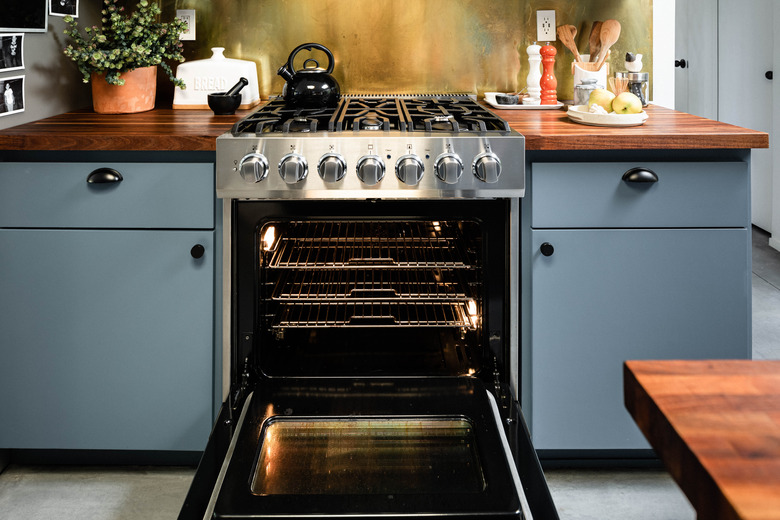Can Pyrex Go In A 400-Degree Oven?
We may receive a commission on purchases made from links.
Before the first Pyrex pie plate was manufactured in 1916, home cooks didn't have access to glass bakeware that withstood both high and low temperatures without breaking. Pyrex casserole dishes and roasters could go into a very hot oven and an icebox or refrigerator with no problem. The brand's glass dishes have been a household name ever since. But today, many home cooks — worried about glass bakeware temperature limits — hesitate before putting their Pyrex dishes in the oven. It's true that modern glass bakeware sometimes cracks or breaks in a hot oven, though this is largely avoidable.
Tip
Pyrex can go in a 400-degree oven, provided it's an oven-safe dish and you've taken certain precautions to minimize the chance that thermal shock occurs.
Glass Dishes and High Temperatures
Glass Dishes and High Temperatures
If a glass pan shatters in the oven, thermal shock is generally to blame. It's caused when glass is exposed to rapidly changing temperatures. Glass expands or contracts in response to heat or cold. When a cold glass dish is put in a hot oven or a hot dish is very suddenly cooled down, different parts of the glass expand or contract at different rates. Cracks may form or the dish could even explode.
The kind of glass used in a dish affects its ability to withstand thermal shock. The original Pyrex oven-safe dishes that your grandparents might have used throughout the 20th century were made with borosilicate glass. Made with boron, this type of glass is highly resistant to extreme temperatures, so it wouldn't break even in a standard oven set at its hottest temperature. In other words, early Pyrex owners didn't have to deal with glass pans shattering in the oven.
At some point in the last few decades — Pyrex won't say exactly when — the company stopped making borosilicate bakeware. Today, oven-safe Pyrex dishes are made from soda-lime glass that has been tempered to increase its durability. This makes tempered glass less prone to cracking than the standard soda-lime glass used to make window panes, though it's not as strong as borosilicate glass. Many kinds of oven-safe bakeware and oven-safe plates are also made with tempered glass.
Putting Pyrex in the Oven
Putting Pyrex in the Oven
Pyrex currently makes a wide range of dishes, bakeware and storage containers. Only some of its dishes are safe to use in the oven at any temperature; make sure you only use baking dishes that are marked as oven-safe in the oven. A Pyrex measuring cup may also be oven-safe. Some Pyrex mixing bowls and dishes are safe for microwave use but shouldn't go in the oven. Don't use Pyrex with a hot plate, over an open flame, on a grill or with any other heating source.
If your Pyrex oven-safe baking dishes have been passed down through generations, they may be made of super durable borosilicate glass. But even if your Pyrex is made of tempered glass, it's very unlikely that it'll explode in a 400-degree oven. There's no standard glass bakeware temperature limit, but these dishes are made to withstand normal baking temperatures.
A small number of reports are made to the Consumer Product Safety Commission each year about glass pans that shattered in the oven, but those reports involve a wide range of oven temperatures. Occasionally, a glass dish will suddenly crack or explode in an oven set at a low temperature. This can happen with any brand of glass bakeware and may be due to user error more than glass bakeware temperature limits.
If you take some steps to prevent thermal shock, your Pyrex oven-safe dishes should be fine in a 400-degree oven. First, always preheat the oven completely before putting the dish in. Don't place cold or frozen food in a Pyrex and put it directly in a hot oven. If you're baking something that will release liquid or fat as it cooks, put a small amount of liquid in the bottom of the dish before it goes in the oven.
Protecting Pyrex Outside the Oven
Protecting Pyrex Outside the Oven
Because any extreme temperature change can cause thermal shock, Pyrex owners need to be mindful about exposing their dishes to cold temps too. When you take a hot dish full of food out of the oven, don't set it down on the cold metal rings of your stove burner or directly on a cold countertop. Set it on a pot holder or dish towel instead.
If you're keeping food in a Pyrex for later, let the dish cool down to room temperature before putting it in the fridge or freezer. Even if you take all the food out of the dish right away, let it sit on the pot holder or towel until it's cool before putting it in the sink for washing. Putting a hot dish in a cold sink or running cool water in a hot dish can create thermal shock.
